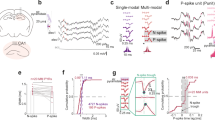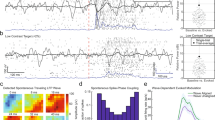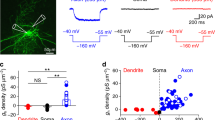Abstract
Nerve terminals are generally considered to be the destination points for electrical signals, which propagate unidirectionally from the soma to nerve terminals. We found that small hyperpolarizations or depolarizations (∼10 mV) generated under physiological conditions in rat nerve terminals backpropagated up the axon (∼400–800 μm) and changed the threshold for initiating action potentials and thus firing patterns. These results suggest a mechanism for information processing in neurons and neuronal circuits.
This is a preview of subscription content, access via your institution
Access options
Subscribe to this journal
Receive 12 print issues and online access
$209.00 per year
only $17.42 per issue
Buy this article
- Purchase on Springer Link
- Instant access to full article PDF
Prices may be subject to local taxes which are calculated during checkout


Similar content being viewed by others
References
Rodriguez-Contreras, A., de Lange, R.P., Lucassen, P.J. & Borst, J.G. J. Comp. Neurol. 496, 214–228 (2006).
Kim, J.H., Sizov, I., Dobretsov, M. & von Gersdorff, H. Nat. Neurosci. 10, 196–205 (2007).
Borst, J.G., Helmchen, F. & Sakmann, B. J. Physiol. (Lond.) 489, 825–840 (1995).
Shu, Y., Hasenstaub, A., Duque, A., Yu, Y. & McCormick, D.A. Nature 441, 761–765 (2006).
Alle, H. & Geiger, J.R. Science 311, 1290–1293 (2006).
Stepanyants, A. & Chklovskii, D.B. Trends Neurosci. 28, 387–394 (2005).
Markram, H., Lubke, J., Frotscher, M., Roth, A. & Sakmann, B. J. Physiol. (Lond.) 500, 409–440 (1997).
Geiger, J.R. & Jonas, P. Neuron 28, 927–939 (2000).
Bielefeldt, K. & Jackson, M.B. J. Neurophysiol. 70, 284–298 (1993).
Engelman, H.S. & MacDermott, A.B. Nat. Rev. Neurosci. 5, 135–145 (2004).
Turecek, R. & Trussell, L.O. Nature 411, 587–590 (2001).
Scott, R., Ruiz, A., Henneberger, C., Kullmann, D.M. & Rusakov, D.A. J. Neurosci. 28, 7765–7773 (2008).
Stevens, C.F. & Wang, Y. Neuron 14, 795–802 (1995).
Malenka, R.C. & Bear, M.F. Neuron 44, 5–21 (2004).
Zucker, R.S. & Regehr, W.G. Annu. Rev. Physiol. 64, 355–405 (2002).
Acknowledgements
We thank J. Diamond, A. Elhamdani, B. McNeil, D. Robinson and J. Xu for insightful comments. This work was supported by the National Institute of Neurological Disorders and Stroke Intramural Program and a K22 Award to K.P. (K22NS051401).
Author information
Authors and Affiliations
Contributions
K.P. designed, performed and analyzed the experiments and wrote the manuscript. L.-G.W. supervised the project and wrote the manuscript.
Note: Supplementary information is available on the Nature Neuroscience website.
Corresponding authors
Supplementary information
Supplementary Text and Figures
Supplementary Figures 1–5, Supplementary Table 1, Supplementary Methods and Supplementary Results (PDF 198 kb)
Rights and permissions
About this article
Cite this article
Paradiso, K., Wu, LG. Small voltage changes at nerve terminals travel up axons to affect action potential initiation. Nat Neurosci 12, 541–543 (2009). https://doi.org/10.1038/nn.2301
Received:
Accepted:
Published:
Issue Date:
DOI: https://doi.org/10.1038/nn.2301



